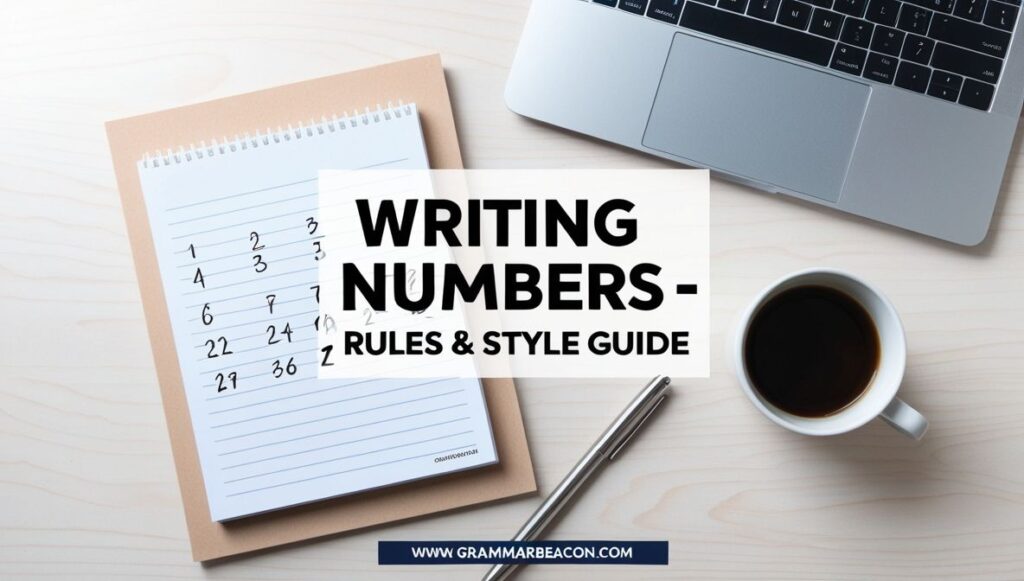When it comes to writing numbers, many people get confused about when to spell out numbers and when to use numerals. Understanding the basics of number formatting rules not only makes your writing clearer but also ensures it follows recognized styles like AP style numbers or Chicago Manual of Style numbers. Whether you’re writing fractions, large numbers, or dates and times, this guide will cover everything you need to know to write numbers correctly and confidently.
When to Spell Out Numbers
Spelling out numbers often depends on the style guide you’re following, but a general rule is to spell out numbers from zero to nine. This is especially true when they appear in casual or literary writing. For example, you’d write “three apples” rather than “3 apples.” Spelling out numbers improves readability in most cases.
Exceptions exist, such as beginning a sentence with a number, where you should always spell it out, like “Twenty people attended.” Some guides allow using numerals if rewriting sounds awkward. Also, common expressions like “a hundred” or “a thousand” are usually spelled out.
When to Use Numerals
You should use numerals for numbers 10 and above, especially in technical or scientific writing. Using numerals makes it easier for readers to scan information, especially with dates and numbers, time formatting, money amounts, and percentages. For example, you’d write “3:30 p.m.” or “\$50” instead of spelling these out.
Certain cases always require numerals regardless of size: addresses, phone numbers, and precise measurements. This rule helps avoid confusion and maintains consistency across formal documents.
Writing Large Numbers
Writing large numbers clearly can be tricky. Generally, use numerals with commas to separate thousands, millions, and billions (e.g., 1,000; 2,500,000). For readability, combine numerals with words, like “2.5 million,” especially when the exact figure isn’t necessary.
Avoid long strings of digits that overwhelm readers. Using an easy way to express large numbers helps your writing flow naturally and remains understandable. The four-digit comma rule is essential here it clarifies when and where to use commas for thousands and beyond.
| Number | Correct Format | Example |
|---|---|---|
| Thousand | 1,000 | The town has 1,000 residents. |
| Million | 2,500,000 or 2.5 million | The company earned 2.5 million dollars. |
| Billion | 3,000,000,000 | The budget is 3,000,000,000 dollars. |
Writing Fractions
When writing fractions, the choice between spelling them out or using numerals depends on clarity and style. Simple fractions like “one-half” or “three-quarters” are usually spelled out. However, in technical writing or recipes, using numerals (1/2, 3/4) is common.
You’ll often see mixed fractions in writing, where whole numbers and fractions combine, such as “2 1/2 cups.” When spelling fractions, use hyphenated numbers to keep the phrasing smooth. For example, “two-thirds majority” is hyphenated to avoid confusion.
Writing Money Amounts
Money formatting grammar demands clarity and consistency. Use the currency symbol followed by numerals, such as “\$100,” and spell out amounts when they begin a sentence or appear in formal prose, like “One hundred dollars.” Large sums may combine numerals and words, for example, “\$3 million.”
Decimals indicate cents and should be written with a decimal point usage (e.g., \$12.50). Avoid mixing words and numerals unnecessarily to maintain smooth readability.
Writing Percentages
When writing percentages in sentences, you can use either numerals or words depending on the style guide and context. The AP style numbers recommends using numerals with the percent sign (%) for all percentages, like “5% increase.”
In academic papers, spelling out “five percent” might be preferred for formality. Consistency is key don’t switch between styles in the same document.
Time Formatting
Using correct time formatting helps avoid confusion. Write times using numerals and lowercase letters with periods, such as “3:30 p.m.” Avoid using “o’clock” in formal writing unless necessary. The 24-hour clock is common in scientific or military contexts.
Always include minutes if they aren’t zero, and use “a.m.” and “p.m.” for clarity. This format aligns with the Chicago Manual of Style numbers and AP guidelines.
Dates and Numbers
When writing dates, use numerals for the day and year, and spell out the month in most cases. For example, “April 5, 2024” is preferred over “4/5/2024” in formal writing.
The decade formatting can include an apostrophe to show omission of numbers (e.g., the ’90s), but style guides differ on this. When writing full years, avoid unnecessary apostrophes.
Frequently Asked Questions
Should I always spell out numbers at the beginning of a sentence?
Yes. Always spell out numbers starting a sentence, but consider rewriting to avoid awkward phrasing.
How do I write large numbers like millions or billions?
Use numerals with commas, or combine numerals with words like “2.5 million” for clarity.
When should I use decimals instead of fractions?
Decimals are preferred in scientific and financial writing; fractions suit casual or recipe contexts.
Final Words
Mastering writing numbers is a small but powerful skill that makes your writing more polished and professional. Whether you’re following AP style numbers or the Chicago Manual of Style numbers, consistency and clarity should guide your choices. Remember, clear communication is the goal so spell out or use numerals in a way that feels natural to your reader. Keep practicing these rules, and soon writing numbers will feel second nature.

James Logan is a seasoned blogger and language enthusiast behind Grammar Beacon. With years of experience in grammar and writing, James shares his expertise through insightful and engaging content. His passion for clear communication and linguistic precision shines in every post, making complex grammar concepts accessible and enjoyable for readers. Follow James for expert advice and tips to refine your writing skills.







